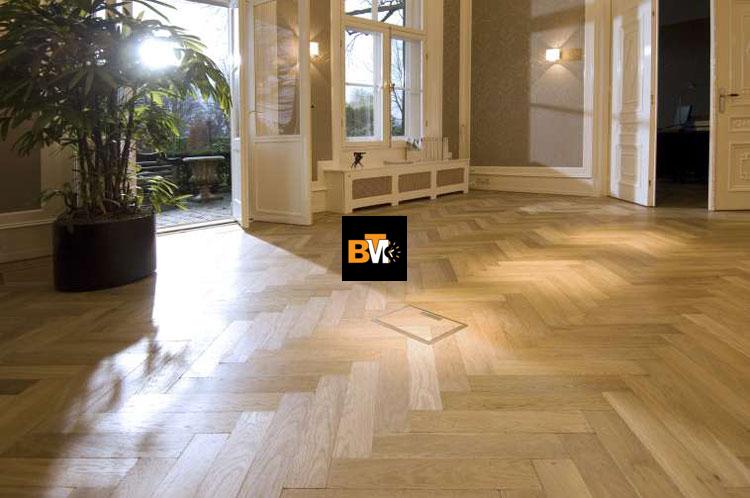Choosing the right wood for herringbone floors is a decision that should be based on style, durability, and personal preference. Each type of wood offers a distinct look. Oak, with its traditional and rustic appearance, often suits those who prefer a classic design. Meanwhile, walnut provides a rich, dark finish for an elegant atmosphere.
Maple stands out with its smooth grain and pale tones, creating a clean and contemporary vibe. When aiming for a unique interior, a collection of Parquet flooring can add a touch of sophistication and timeless charm. Each option has its standout features, catering to diverse tastes and decor styles.
Ultimately, considering the desired aesthetic and the characteristics of each wood type leads to a well-informed choice. With oak, walnut, and maple each offering their own benefits, there’s a perfect fit for anyone looking to invest in quality herringbone flooring.
Essentials of Herringbone Flooring
Herringbone flooring adds a classic touch to any space. Understanding its origins and advantages can help in making a more informed decision when selecting materials and styles.
Herringbone Pattern Origins
The herringbone pattern has historical significance. It traces back to the Roman Empire, where it was first used in road construction. The design resembles the bones of a fish, providing both structural strength and aesthetic appeal. This pattern was adopted during the Renaissance period for its elegance and style in flooring.
Over the years, herringbone has remained popular due to its intricate and timeless look. Its origins in strong construction practices lend it a lasting reputation for combining both form and function in interior design.
Advantages of Herringbone Floors
Herringbone floors offer several benefits, making them a popular choice. The pattern naturally improves visual appeal. Its zigzag design can make rooms appear larger and more dynamic. It suits both modern and traditional interiors, providing versatility in design choices.
Another benefit is the durability of herringbone floors. Timber such as oak, walnut, or maple are commonly used due to their strong and long-lasting nature. Each type of wood offers unique grain patterns and colours, allowing for personalised design without losing the timeless charm of the herringbone style.
Selecting the Right Wood
Choosing the right wood for herringbone floors involves considering various features. Oak, walnut, and maple each bring unique characteristics to this classic floor pattern. Understanding the strengths and qualities of each type of wood helps in making the best choice for different spaces.
Characteristics of Oak
Oak is a popular choice for herringbone floors due to its strength and durability. It offers a classic appearance that suits both traditional and modern interiors. Its natural grain and texture create a warm ambience, making spaces feel welcoming.
It comes in a variety of shades, from light to dark, allowing for flexibility in design. Oak is known for its resilience against wear and tear, making it suitable for high-traffic areas. It is also easy to stain, providing even more options in terms of finished colour. This makes oak a versatile option for anyone considering a stylish yet long-lasting floor choice.
Benefits of Walnut
Walnut is appreciated for its rich, dark colour and sleek appearance. It adds a touch of elegance and luxury to any room. The deep brown tones of walnut can complement contemporary and classic aesthetics, providing an upscale feel.
This wood type has a straight grain pattern that improves its sophisticated look. While it is slightly softer than oak, walnut’s beauty often outweighs this factor for many homeowners. Walnut is ideal for spaces where aesthetics are a priority, creating an atmosphere of comfort and opulence.
Maple Attributes
Maple is celebrated for its clean and airy look, making it a fantastic choice for modern and minimalist designs. Its pale colour and fine, even grain pattern offer a bright and open feel to spaces.
Maple’s hardness makes it a practical option, standing up well to scratches and impacts. It offers a smooth finish that is easy to maintain. Maple provides aesthetic appeal and performance for those seeking a fresh and light appearance in their flooring.
Factors to Consider
When selecting wood for herringbone floors, consider several factors, including the room’s function, style preference, and maintenance needs. Durability is important for high-traffic areas, while style and colour can define the room’s character.
Budget can also influence choices, as some wood types may be more costly than others. Additionally, consider how much natural light the room receives, as this can affect how the wood’s colour appears throughout the day. Keeping these practical and visual elements in mind assists in making the best decision for your space.
Conclusion
Choosing the right wood for herringbone floors involves considering both aesthetics and practicality. Oak, walnut, and maple each offer unique benefits.
Oak presents a classic, rustic look with its rich grain patterns. Walnut stands out with its elegant, dark tones. Maple provides a light, refined appearance with a tight, uniform grain.
Ultimately, the best choice depends on personal style and the overall feel of the space.







Leave a Reply